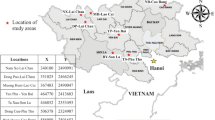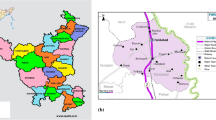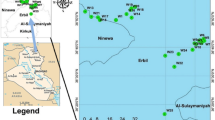Abstract
The 222Rn activity concentration was determined in salty underground and spring water in Jeju, Korea. The activities of radon in salty underground water and spring water were in the range of 0.40–3.77 and 0.65–20.65 Bq L−1, respectively. The radon concentration was higher in spring water in southern Jeju Island than in other regions. The effective dose of the age groups of adults due to intake of 222Rn from salty underground water varied from 1.01 to 9.64 μSv y−1. And the effective doses of spring water were in the range of 1.7–52.8 μSv y−1.



Similar content being viewed by others
References
Ramachandran TV (2011) Background radiation, people and the environment. Iran J Radiat Res 9(2):63–76
ICRP (1993) Protection against radon-222 at home and at works. ICRP Publication 65. Ann. ICRP 23(2)
Al-Khateeb HM, Al-Qudah AA, Alzoubi FY et al (2012) Radon concentration and radon effective dose rate indwellings of some villages in the district of Ajloun, Jordan. Appl Radiat Isot 70:1579–1582
Ju YJ, Ryu YH, Jang HC et al (2012) A study on concentration measurements of Radon-222 (Uranium Series) and Radon-220 (Thoron Series) emitted to the atmosphere from tex (cementitious), red brick, and ecocarat among construction materials. J Korean Phys Soc 60(7):1177–1186
National Research Council (1999) Risk assessment of exposure to radon in drinking water. National Academy Press, Washington DC
Milvy P, Cothern CR (1990) Scientific background for the development of regulations for radionuclides in drinking water. Chapter 1 in Cothern and Rebers
Crawford-Brown DJ (1989) The biokinetics and dosimetry of radon-222 in the human body following ingestion of groundwater. Environ Geochem Health 11:10–17
Crawford-Brown DJ (1991) Cancer fatalities from waterborne radon (Rn-222). Risk Anal 11:135–143
Hahn J, Hahn K, Kim C et al (1994) Sustainable yield of groundwater resources of the Cheju Island. J Geol Soc Korea 1(1):33–50
Won JH, Kim JW, Koh GW et al (2005) Evaluation of hydrogeological characteristics in Jeju Island. Korea Geo Sci J 9(1):33–46
Won JH, Lee JY, Kim JW et al (2006) Groundwater occurrence on Jeju Island, Korea. Hydrogeol J 14:532–547
Somlai K (2007) 222Rn concentrations of water in the Balaton Highland and in the southern part of Hungary, and the assessment of the resulting dose. Radiat Meas 42:491–495
UNSCEAR (United Nations Scientific Committee on the Effects of Atomic Radiation) (2000) Sources and effects of ionizing radiation; Report to the General Assembly, with Scientific Annexes. United Nations, New York
WHO (2004) Guidelines for third edition recommendations drinking-water quality. Geneva 1.
Galán López M, Martín Sánchez A, Gómez Escobar V (2004) Estimates of the dose due to 222Rn concentrations in water. Radiat Prot Dosimetry 111(1):3–7
Mullinger NJ, Binley AM, Pates JM, Crook JP (2007) Radon in Chalk streams, spatial and temporal variation of groundwater sources in the Pang and Lambourn catchments. J Environ Radioactivity 339:172–182
Cho BW, Kim HK, Kim MS et al (2019) Radon concentrations in the community groundwater system of South Korea. Environ Monit Assess 191(3):189
Hopke PK, Borak TB, Doull J et al (2000) Health risks due to radon in drinking water. Environ Sci Technol 34:921–926
Xinwei L (2006) Analysis of radon concentration in drinking water in Baoji (China) and the associated health effects. Radiat Prot Dosimetry 121:452–455
Borio R, Rongoni A, Saetta DMS et al (2005) Radon and tritium measurements in drinking water in a region of central Italy (Umbria). J Radioanal Nucl Chem 266:397–403
Ali N, Khan E, Akhter P et al (2010) Estimation of mean annual effective dose through radon concentration in the water and indoor air of Islamabad and Murree. Radiat Prot Dosimetry 141:183–191
Alirezazadeh N (2005) Radon concentrations in public water supplies in Tehran and evaluation of radiation dose. Iran J Radiat Res 3(2):79–83
Alabdulàly AI (1999) Occurrence of radon in the central region groundwater of Saudi Arabia. J Environ Radioact 44:85–95
Lima JLN, Bonotto DM (1996) Etapas analiticas para mensuracao de radonio-222 e uso na avaliacao da radioatividade das aguas de Aguas da Prata(sp). Geochimica Brasiliensis 10(2):283–295
Al-Bataina BA, Ismail AM, Kullab MK et al (1997) Radon measurements in different types of natural waters in Jordan. Radiat Meas 28(1):591–594
Horvath A, Bohus LO, Urbani F et al (2000) Radon concentrations in hot spring waters in northern Venezuela. J Environ Radioact 47:127–133
Yiğitoğlu I, Öner F, Yalim H et al (2010) Radon concentrations in water in the region of Tokat city in Turkey. Radiat Prot Dosimetry 142:358–362
Koh GW (2006) Characteristics of groundwater and water resource management in Jeju Island (III). J Kor Water Res 39(8):80–89
Acknowledgements
This research was supported by Basic Science Research Program through the National Research Foundation of Korea (NRF) funded by the Ministry of Education (2019R1A6A1A10072987).
Author information
Authors and Affiliations
Corresponding author
Additional information
Publisher's Note
Springer Nature remains neutral with regard to jurisdictional claims in published maps and institutional affiliations.
Rights and permissions
About this article
Cite this article
Han, CH., Hong, J.W. & Im, HJ. A study of 222Rn concentration of salty underground water and spring water in Jeju, Korea. J Radioanal Nucl Chem 330, 563–569 (2021). https://doi.org/10.1007/s10967-021-07909-3
Received:
Accepted:
Published:
Issue Date:
DOI: https://doi.org/10.1007/s10967-021-07909-3




